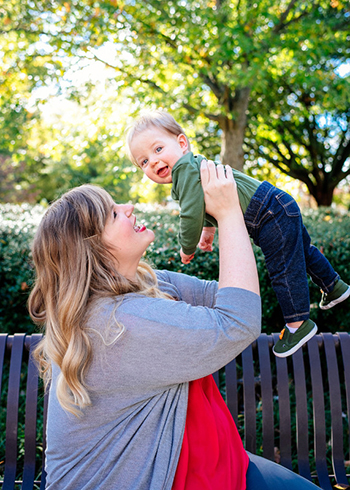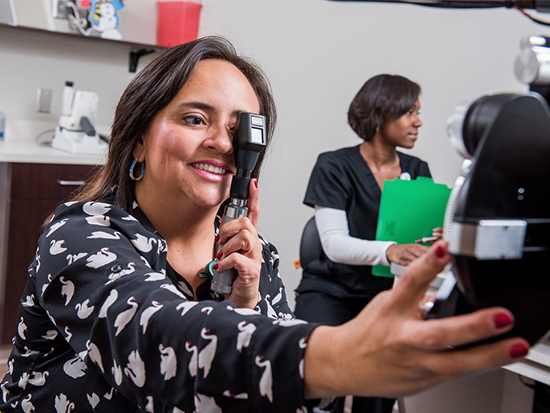 Martindale's corneal abrasion is one of the most common injuries seen at UAB Callahan Eye.It was about seven o’clock on a regular work night. Jessica Martindale and her then 6-month old son, Henry, were playing on the bed before they started their nighttime routine. They were touching noses and playing peek-a-boo when, out of nowhere, his right hand swiped across Martindale’s left eye.
Martindale's corneal abrasion is one of the most common injuries seen at UAB Callahan Eye.It was about seven o’clock on a regular work night. Jessica Martindale and her then 6-month old son, Henry, were playing on the bed before they started their nighttime routine. They were touching noses and playing peek-a-boo when, out of nowhere, his right hand swiped across Martindale’s left eye.
She had poked her own eye numerous times in the past accidently, but she knew this time felt different. She had trouble opening it, and Martindale’s instincts told her to keep it closed. She secured Henry in his jumper so she could look into a mirror to assess the damage. At first it looked normal, but Martindale noticed a shooting pain sensation that was not going away, and every time she blinked that pain shot across the corner of her eye.
“My first thought was ‘My son has scratched my eye,’” she said.
Martindale’s husband came home from work and she explained what had happened. They decided to wait until the next morning so she could just visit UAB Callahan Eye Hospital and have someone look at it.
That did not last long.
Martindale, an employee with the University of Alabama at Birmingham Marnix E. Heersink School of Medicine, woke up around 10 p.m. that same evening not able to open her eye. The fear had started to set in that her eye really was scratched.
“This had never happened to me before, so I didn’t quite know how to process it,” she said.
She and her husband decided it was time to visit the UAB Callahan Eye Hospital Emergency Department because she did not think it could wait until morning.
“No one wants to go back to work late at night in jeans and a T-shirt, but I knew at this point she needed answers,” her husband said. “We couldn’t have had a better experience.”
Martindale says she had had perfect vision her whole life, so she had not had many doctors poking around and checking out her eyes.
“Needless to say, I was very nervous, but the Emergency Department physicians and staff made me feel safe and comforted, and most importantly, they let me know my vision was going to be all right,” she said.
However, Martindale’s assumptions were correct: Her son had scratched her eye. She was given some antibiotic drops and instructions to follow up with one of the UAB Callahan Eye physicians the next morning.
“Corneal abrasions are one of the most common injuries that present to our emergency department,” said Priscilla Fowler, M.D., assistant professor in the department and cornea service director. “They can occur from something as simple as rubbing the eye too vigorously or trauma from being poked in the eye with a finger. Abrasions typically cause severe pain in the eye because the cornea is one of the most pain-sensitive tissues in the whole body. Immediate treatment is necessary to avoid the risk of infection and to ensure proper healing so that vision is not affected long-term.”
 Marcela Frazier, O.D.Fowler saw Martindale the next morning in clinic, and for the following two weeks just to make sure her eye was healing as it should. Once the pain subsided after a few days, Martindale was left with a consistent scratchiness that eventually went away with the help of eye drops.
Marcela Frazier, O.D.Fowler saw Martindale the next morning in clinic, and for the following two weeks just to make sure her eye was healing as it should. Once the pain subsided after a few days, Martindale was left with a consistent scratchiness that eventually went away with the help of eye drops.
Infants are at a high risk too.
Corneal abrasions do not happen only to adults — infants are at a high risk.
Lucy Hoyle noticed her 6-month old daughter, Melody, was not acting as she normally did.
“Melody had just woken up from a nap and just continued to cry,” Hoyle said. “She kept rubbing her right eye and was struggling to keep her eyes open. I also started to notice she wasn’t blinking. Her right eye eventually started to swell, so I knew it was time to visit UAB Callahan Eye.”
Melody was seen by Marcela Frazier, O.D., associate professor in the UAB Department of Ophthalmology and Visual Sciences.
“‘My baby’s eye is suddenly red and watery, and she is acting like she’s in a lot of pain’ is a common complaint we hear from parents, and it can be conjunctivitis, or ‘pink eye,’ but it can also be a corneal abrasion,” Frazier said. “Corneal abrasions are injuries to the top layer of the cornea. They are usually superficial and can heal quickly, but they are also very painful and could potentially get infected. If a corneal abrasion is suspected, the child should have an evaluation in which the physician uses a special dye with a cobalt blue light to determine the extent of the damage. An antibiotic drop is usually prescribed to prevent infection, along with another drop to reduce pain and light sensitivity while the abrasion heals.”
Signs and symptoms of a corneal abrasion include:
- A pain that could be worse when you open or close your eye
- Redness
- Sensitivity to light
- Blurred vision
- Headache
If you or your child experiences a corneal abrasion:
- Do not touch your eye with anything, including your finger.
- Do not wear contact lenses.
- Do not rub your eye.
- Do wear sunglasses to help with light sensitivity.
“Henry is almost 8 months old now and loves to grab faces,” Martindale said. Martindale’s family has an inside joke they always say when he grabs her face in particular. “He does tend to go for my eyes, so they say, ’Oh, you’re trying to poke out momma’s good eye.’ But everything is fine now with my eye and my sight. I’m just happy to have had a place like the UAB Callahan Eye to treat my injury and get me back on track.”
